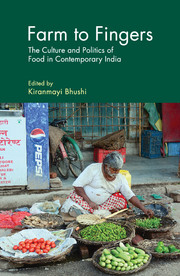Book contents
- Frontmatter
- Dedication
- Contents
- List of Figures and Tables
- Preface
- 1 Introduction
- 2 The Making of ‘Edible Animal Source Foods’ and its Contemporary Reality in Delhi
- 3 Appropriating the Cow: Beef and Identity Politics in Contemporary India
- 4 Eating Akhuni in India
- 5 Health, Standardization and ‘Bengali’ Sweets
- 6 Treating Children, Feeding Junk Food: An Inquiry into a Middle Class Project
- 7 Diaspora Dish: Cooking, Writing, and Creating Identities in Food-blogs
- 8 Measuring Hunger: Debates on an ‘Adequate’ Diet in Colonial North India
- 9 Managing Food: India's Experience with the Public Distribution System
- 10 Food Sovereignty: The Future of Food
- Contributors
- Index
Preface
Published online by Cambridge University Press: 05 July 2018
- Frontmatter
- Dedication
- Contents
- List of Figures and Tables
- Preface
- 1 Introduction
- 2 The Making of ‘Edible Animal Source Foods’ and its Contemporary Reality in Delhi
- 3 Appropriating the Cow: Beef and Identity Politics in Contemporary India
- 4 Eating Akhuni in India
- 5 Health, Standardization and ‘Bengali’ Sweets
- 6 Treating Children, Feeding Junk Food: An Inquiry into a Middle Class Project
- 7 Diaspora Dish: Cooking, Writing, and Creating Identities in Food-blogs
- 8 Measuring Hunger: Debates on an ‘Adequate’ Diet in Colonial North India
- 9 Managing Food: India's Experience with the Public Distribution System
- 10 Food Sovereignty: The Future of Food
- Contributors
- Index
Summary
The title of the book Farm to Fingers is an allusion to the Farm to Fork movement, (the movement acknowledges the act of growing food and the role of farmers in bringing food to the table) albeit, by replacing the fork with fingers, to capture the Indian sensibility of its food culture. Fingers are the preferred accoutrement for eating in India, practically in all of India. Yet, it somehow denotes a rustic and boorish table manner that divides the hoi polloi from the genteel. Notwithstanding this association of cutlery with haute table manners, there is a self-conscious validation of eating with fingers by certain sections of Indians by referring to an ancient wisdom. The website hinduhumanrights.info, for instance, expresses that ‘the practice of eating with the hands originated within Ayurvedic teachings. The Vedic people knew the power held in the hand.’ Often the ancient wisdom is buttressed by the use of scientific terminology such as how the digestive enzymes are stimulated by the nerve endings that connect finger tips to various parts of the body (Patel 2012).
The search for roots, and traditions as alternatives to mechanistic and capitalistic modes of food production and distribution have spawned a range of self-conscious practices and movements around food: farm to fork, locivore, veganism, dumpster diving, guerilla gardening to mention a few, and eating with fingers may be the next trend. There are restaurants in US that encourage people to eat with their hands, ‘several high-profile chefs are asking diners to get their hands dirty, in the belief that it heightens the sensual connection to food and softens the formality of fine dining,’ reports New York Times in an article – ‘Mind your Manners: Eat With Your Hands’ (DiGregorio 2012).
While eating with hands may be valorized in certain contexts, not being touched by hand, on the other hand, signals that food has not been contaminated and that it is hygienic. Notions of hygiene which are backed by ‘science’ seem to streamline process of productions and notions around food, despite the cultural specificities that surround ideas about hygiene involving food. And yet the term ‘handpicked’ in the larger context of mechanization of agro-production has certain valorization denoting exclusivity.
- Type
- Chapter
- Information
- Farm to FingersThe Culture and Politics of Food in Contemporary India, pp. xi - xivPublisher: Cambridge University PressPrint publication year: 2017

